Abstract
Load balancing and interference management influence the performance of heterogeneous network (HetNet). Cell range expansion (CRE) scheme has been introduced to achieve better load balance by adding a positive bias to the small-cell BSs. Enhanced inter cell interference coordination (eICIC) is recognized as a solution that reduces cross-tier interference by setting the almost blanking subframes (ABS). In this paper, we divide pico area into pico inner part (the normal coverage area of pico) and pico CRE part (bias area assigned to pico). We propose that the macro only transmits data during non-ABS subframes. The pico CRE part transmits data to its users in ABS subframes, and pico inner part transmits over all subframes. The users within different base stations have different interference patterns, and therefore we compute it independently. Then we derive the optimal ABS value by optimizing the system throughput equation. After performing the extensive simulation, we get the proper CRE value. And the proposed ABS scheme has shown remarkable results.
Access provided by CONRICYT-eBooks. Download conference paper PDF
Similar content being viewed by others
Keywords
1 Introduction
To solve the boosting increase of the data demand, many solutions such as massive multiple-input multiple-output (MIMO) [1], millimeter wave, heterogeneous network (HetNet) have been proposed. Low power base station, such as micro, pico or femto cells are deployed into conventional macro cell systems in [2, 3]. In [4, 5], small cells can expand the macro coverage by deploying them into cell edge areas, and it can be deployed into high traffic demand areas to offload users. For a given HetNet topology, a cross tier interference is also an important issue. If macros and picos share the same frequency, the users within pico cells, especially within pico cell range expansion (CRE) area, suffer severe cross-tier interference from macro cells. To guarantee an acceptable quality of service (QoS) for users within picos, enhanced inter cell interference coordination (eICIC) scheme was introduced. In [6], eICIC can significantly mitigate the inter-cell interference (macro to pico cell). Despite it may decrease the system throughput, but it can mitigate interference to improve the QoS for users. In [7], the authors propose an algorithm to derive the optimal value of eICIC parameters based on data of actual propagation data and traffic load. The results have shown that the method can obtain system gain by a real RF plan using joint optimization design of ABS and UE-association based on actual network data. The author has explored the system performance with different eICIC parameters in different simulation scenarios. The authors in [8] formulate the problem of choosing a proper user association method and ABS value jointly for sum weighted logarithmic utility maximization while maintaining proportional fairness of users. In [9], the authors use stochastic geometry tool to provide the probabilistic characterization of the downlink coverage and single user throughput of the mobile user that in the randomly located situation, and the system can offload users to small cells.
The main contributions of this paper can summarize as follows. We put forward a method to find the optimal ABS value in HetNet. The goal is to maximize the sum throughput of the system and mitigate inter-cell interference simultaneously. Then, simulation has been performed for the proposed ratio of ABS subframe in different environments (different CRE values) to get better CRE value while achieving max throughput.
The rest of this paper is organized as follows. Section 2 presents the system model and formulates the system interference. Section 3 derives the optimal ABS proportion. Finally, Sect. 4 gets a simulation results and concluding remarks are given in Sect. 5.
2 System Model
We consider a two-tier HetNet system that consists of a number of macro BSs and corresponding picos. As shown in Fig. 1, the picos are deployed into the cellular to offload users from macro base stations. In such a deployment environment, users in the pico coverage area may receive interference from other picos and strong cross-tier interference from the macro BSs, especially the users within the CRE. If the interference is not properly controlled, the network performance may be limited severely. However, the proportion of ABS is also very important. If the proportion is too large, it will affect the transmission of the macro base station. If too small, it did not play its usefulness. Moreover, a reasonable proportion of distribution can improve system performance, so as the value of CRE.
The users can be divided into MBSU (users within macro base station), PINU (users within the pico cell inner part) and PCREU (users within pico CRE). Depending on the different base station they connected to.
As seen from Fig. 2, the ABS presents by black subframe, and it means the BS doesn’t transmit data during it. In addition to ABS, we can call the normal subframes NABS. Macro BS only transmit data during NABS and PINU transmits data during all subframes. PCREU transmit only during ABS subframes. Based on this observation, we consider the following policy. MBSU suffer interference from the rest of macros and all picos. PINU suffer interference from the rest of pico stations and all Macro stations. PCREU only transmits data during ABS subframes, and all macros keep silent. The PCREU only interfered by pico base stations.
According to the above description, we can list the interference functions of different category of users. In Eq. (1), the \( {\text{I}}_{{{\text{u}}b}} \) illustrates the interference of user u connected to station b. The sets of macro and pico stations are M and P. Then, m (k) presents one of the stations belongs to M (P). \( P_{m} \) (\( P_{k} \)) presents the transmit power of macro station (pico station), and \( G_{um} \) (\( G_{uk} \)) means the channel pathloss of user u connected to macro base station m (pico station k). The \( {\text{I}}_{\text{ub}} \) can be written as
In this system, the combination of the eICIC and CRE divide users into three parts and compute interference independently. It can mitigate the inter-tier interference and increase the spectral reuse simultaneously. So selecting the proper ABS proportion is very important and will be shown in the next section.
3 Problem Solution
The signal to interference plus noise ratio \( {\text{SINR}}_{\text{ub}} \) of user \( u \) within BS \( b \) can be written as equation
where \( P_{b} \) denotes the transmit power of base station (Macro, pico inner, pico CRE). \( N_{0} \) denotes the noise spectral power density. \( h_{ub} \) denotes the channel gain from base station \( b \) to the user \( u \), according to Eq. (2), the rate of user \( u \) within BS \( b \) can be written as
then proposed value of \( A_{n} \left( \alpha \right) \) is formulated in Eq. (4), the proportion of ABS is \( \alpha \) and NABS is \( 1 - \alpha \), \( A_{n} \left( \alpha \right) \) is as follow
From (3) and (4), we can get the throughput equation of the whole system easily. It is shown as
and assume that the system contains B base stations. B consist of n macro BSs and B-n pico BSs. And the amount of users in the whole system is U. The max value of system throughput can be written as
and it is the main expression that we want to optimize. The value range of ABS is \( 0 \le\upalpha \le 1 \), then add it as a constraint of the (6). The problem becomes a joint optimization problem that can show as
and we make a little change that written (7) as the product of dependent variable of \( \alpha \) and constant part without \( \alpha \). It is shown as
We derived the two-order-partial derivative of function Q. Also, the process of calculating is shown as
After calculating the two-order-partial derivative, we can find the result is less than zero. So that the above optimization problem is a concave function, moreover the constraint is a linear function. According to above points, we can see that formula (7) is a convex optimization problem. Then we calculate the partial derivative of Q to \( \alpha \) and let the result equal to zero. It can be express in
finally, we can get the unconstrained optimal expression of ABS proportion \( \alpha^{{\mathcal{L}}} \) as
The approximate value of \( \alpha^{{\mathcal{L}}} \) is the ratio of the number of PCREU to all cellular users.
4 Performance Evaluation
We consider a two-tier HetNet with same frequency deployment of 3 macros and 18 p. There are three-sector in a macro BS, and each sector consists of 2 p. The ratio of user distributed in pico inner area and pico CRE area is 2:1. In each cellular of macro, there are 40 users connected with macro BSs and 18 users with pico. The users uniformly distributed in each eNB. The pathloss model and other parameters are displayed in Table 1.
System throughputs with different CRE values are displayed in Fig. 3. With CRE, more users can be offloaded to small cells like picos that have weaker signal strength but more available resources. By assigning different bias (CRE value) to picos, we can get different system throughputs. Through observation, we can find that when CRE = 3 dB, the CDF (cumulative distribution function) of system throughput reaches the maximum. Furthermore, higher CRE is not always better.
An appropriate value can achieve the best system performance. In Fig. 4, we analyze the system throughput influenced by different ABS proportion. The users connected to pico CRE areas are 18, and the whole system has 174 users, approximately, this ratio equals 0.1. When the ABS proportion is 0.1 (the rate that we derived from Eq. (11)), system throughput is maximized. The proposed method proved to be reasonable.
5 Conclusions
In this paper, we get the optimal ABS allocation value that approximately equal to the ratio of the amount of the users within pico CRE area to whole system users by optimizing the system throughput in two-tier HetNet. We conducted simulations to evaluate the performance of the proposed algorithm. The results demonstrate that the proposed method and proper CRE value can maximize the system throughput and the cross-tier interference can be reduced simultaneously. The HetNet comprises of more users can be investigated in future works.
References
Chen, N., Rong, B., Zhang, X., Kadoch, M.: Scalable and flexible massive MIMO precoding for 5G H-CRAN. IEEE Wirel. Commun. Mag. 24(1), 46–52 (2017)
Damnjanovic, A., et al.: A survey on 3GPP heterogeneous networks. IEEE Wirel. Commun. 18(3), 10–21 (2011)
Sun, S., Gong, L., Rong, B., Lu, K.: An intelligent SDN framework for 5G heterogeneous networks. IEEE Commun. Mag. 53(11), 142–147 (2015)
Wang, Y., Soret, B., Pedersen, K.I.: Sensitivity study of optimal eICIC configurations in different heterogeneous network scenarios. In: 2012 IEEE International Conference on Communications (ICC), Ottawa, ON, pp. 6792–6796 (2012)
Liu, C., Li, M., Hanly, S.V., Whiting, P.: Joint downlink user association and interference management in two-tier hetnets with dynamic resource partitioning. IEEE Trans. Veh. Technol. 66(2), 1365–1378 (2017)
Zhou, H., Ji, Y., Wang, X., Yamada, S.: eICIC configuration algorithm with service scalability in heterogeneous cellular networks. IEEE/ACM Trans. Netw. 25(1), 520–535 (2017)
Deb, S., Monogioudis, P., Miernik, J., Seymour, J.P.: Algorithms for enhanced inter-cell interference coordination (eICIC) in LTE HetNets. IEEE/ACM Trans. Netw. 22(1), 137–150 (2014)
Fooladivanda, D., Rosenberg, C.: Joint resource allocation and user association for heterogeneous wireless cellular networks. IEEE Trans. Wireless Commun. 12(1), 248–257 (2013)
Wang, H., Zhou, X., Reed, M.C.: Coverage and throughput analysis with a non-uniform small cell deployment. IEEE Trans. Wirel. Commun. 13(4), 2047–2059 (2014)
Acknowledgement
This work thanks to the project 61471066 supported by NSFC.
Author information
Authors and Affiliations
Corresponding author
Editor information
Editors and Affiliations
Rights and permissions
Copyright information
© 2018 Springer Nature Singapore Pte Ltd.
About this paper
Cite this paper
Wu, R., Sun, S., Ullah, Y. (2018). Load Balancing and Interference Management in Heterogeneous Networks. In: Sun, S., Chen, N., Tian, T. (eds) Signal and Information Processing, Networking and Computers. ICSINC 2017. Lecture Notes in Electrical Engineering, vol 473. Springer, Singapore. https://doi.org/10.1007/978-981-10-7521-6_6
Download citation
DOI: https://doi.org/10.1007/978-981-10-7521-6_6
Published:
Publisher Name: Springer, Singapore
Print ISBN: 978-981-10-7520-9
Online ISBN: 978-981-10-7521-6
eBook Packages: EngineeringEngineering (R0)








